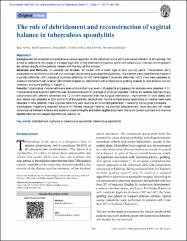| dc.contributor.author | Gökçe, Alper | |
| dc.contributor.author | Öztürkmen, Yusuf | |
| dc.contributor.author | Mutlu, Savas | |
| dc.contributor.author | Gökay, Nevzat Selim | |
| dc.contributor.author | Tonbul, Murat | |
| dc.contributor.author | Caniklioğlu, Mustafa | |
| dc.date.accessioned | 2022-05-11T14:36:08Z | |
| dc.date.available | 2022-05-11T14:36:08Z | |
| dc.date.issued | 2012 | |
| dc.identifier.issn | 0019-5413 | |
| dc.identifier.issn | 1998-3727 | |
| dc.identifier.uri | https://doi.org/10.4103/0019-5413.93674 | |
| dc.identifier.uri | https://hdl.handle.net/20.500.11776/8381 | |
| dc.description.abstract | Background: An accepted comprehensive clinical approach to the deformed spine with tuberculous infection is still lacking. We aimed to determine the usage of a staged algorithm in the treatment of kyphotic spine with tuberculous infection and to present the clinical results of the patients treated with the help of this protocol. Materials and Methods: 54 patients (28 females, 26 males) with a mean age of 39.2 (22-76) years. Preoperative, early postoperative, and followup clinical and radiologic results were evaluated retrospectively. The patients were classified into Kaplan A (kyphotic deformity < 30 degrees), Kaplan B (kyphotic deformity 30 degrees-60 degrees) and Kaplan C (kyphotic deformity > 60 degrees). They were operated by posterior instrument with anterior debridment (Kaplan A), debridment with anterior bone grafting (Kaplan B) and anterior column resection and bone grafting in Kaplan C. Results: Tuberculous involvement were seen at more than one level in 40 patients and paraspinal abscess were detected in 31. Preoperative focal kyphotic deformity was reconstructed with an average of 19 (9-38) degrees. Twenty-six patients had neurologic compromise with different severities and 12 of them improved after the surgical intervention. Improvement in work ability and pain status was detected in 52 and 61 of the patients, respectively. Wound complications responding to medical care were detected in nine patients. Initial kyphotic deformity was found as an important parameter in selecting the surgical procedure. Conclusion: Regarding resected amount of infected osseous material, as planned preoperatively, have resulted with better concordance between anterior and posterior column heights and better sagittal alignment. We could correct kyphosis and improve sagittal balance with staged algorithm as used by us. | en_US |
| dc.language.iso | eng | en_US |
| dc.publisher | Wolters Kluwer Medknow Publications | en_US |
| dc.identifier.doi | 10.4103/0019-5413.93674 | |
| dc.rights | info:eu-repo/semantics/openAccess | en_US |
| dc.subject | Debridement | en_US |
| dc.subject | kyphosis in tuberculous spondylitis | en_US |
| dc.subject | tuberculous spondylitis | en_US |
| dc.subject | Spinal Tuberculosis | en_US |
| dc.subject | Posterior Instrumentation | en_US |
| dc.subject | Deformity | en_US |
| dc.subject | Kyphosis | en_US |
| dc.subject | Surgery | en_US |
| dc.subject | Deficit | en_US |
| dc.subject | Lumbar | en_US |
| dc.subject | Angle | en_US |
| dc.title | The role of debridement and reconstruction of sagittal balance in tuberculous spondylitis | en_US |
| dc.type | article | en_US |
| dc.relation.ispartof | Indian Journal of Orthopaedics | en_US |
| dc.department | Fakülteler, Tıp Fakültesi, Cerrahi Tıp Bilimleri Bölümü, Ortopedi ve Travmatoloji Ana Bilim Dal | en_US |
| dc.identifier.volume | 46 | en_US |
| dc.identifier.issue | 2 | en_US |
| dc.identifier.startpage | 145 | en_US |
| dc.identifier.endpage | 149 | en_US |
| dc.institutionauthor | Gökçe, Alper | |
| dc.institutionauthor | Gökay, Nevzat Selim | |
| dc.institutionauthor | Tonbul, Murat | |
| dc.relation.publicationcategory | Makale - Uluslararası Hakemli Dergi - Kurum Öğretim Elemanı | en_US |
| dc.authorscopusid | 14622670700 | |
| dc.authorscopusid | 6506370457 | |
| dc.authorscopusid | 26022488100 | |
| dc.authorscopusid | 37095337000 | |
| dc.authorscopusid | 8450175300 | |
| dc.authorscopusid | 23468840000 | |
| dc.identifier.wos | WOS:000301861700004 | en_US |
| dc.identifier.scopus | 2-s2.0-84859096345 | en_US |
| dc.identifier.pmid | 22448051 | en_US |



















